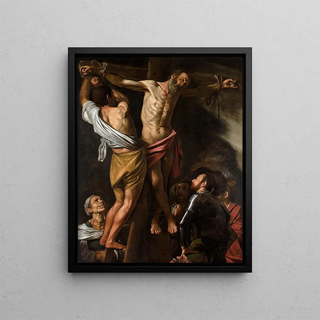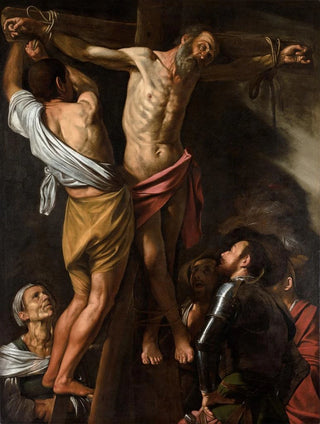Art print | The Crucifixion of Saint Andrew - Caravaggio


View from behind

Frame (optional)
La Crucifixion of Saint Andrew, an iconic work by Caravaggio, embodies the essence of Baroque art through its dramatic intensity and bold use of light. This painting, depicting the Christian martyr Andrew, is part of an artistic tradition where the sacred and the profane intersect, revealing the depth of faith and the struggle against adversity. As viewers contemplate this piece, they are immediately transported into a world where pain and transcendence intertwine, offering an unforgettable visual experience. Caravaggio's mastery in portraying human emotions and biblical scenes reaches its peak here, making this work a must-see in art history.
Style and uniqueness of the work
The Crucifixion of Saint Andrew stands out for its daring treatment of light and shadow, a technique that Caravaggio perfected throughout his career. Light bursts forth, highlighting expressions of suffering and devotion, while shadows envelop the characters, creating an atmosphere of palpable tension. The color palette, both dark and vibrant, also contributes to the emotional impact of the scene. Andrew's posture, suspended between heaven and earth, evokes an inner struggle, a quest for meaning in the face of the fear of death. Caravaggio does not merely depict a crucifixion scene; he invites viewers to feel the anxiety, faith, and resignation, making the work profoundly human and accessible.
The artist and his influence
Michelangelo Merisi da Caravaggio, known as Caravaggio, is one of the most influential artists of the Baroque period. His tumultuous life, marked by excesses and conflicts, is reflected in his art, where he explores themes of mortality, redemption, and suffering. Caravaggio revolutionized painting in his time by introducing striking realism, portraying characters from everyday life, often in dramatic situations. His innovative approach inspired many artists, such as Rembrandt and Caravaggio himself, who sought to

Matte finish

View from behind

Frame (optional)
La Crucifixion of Saint Andrew, an iconic work by Caravaggio, embodies the essence of Baroque art through its dramatic intensity and bold use of light. This painting, depicting the Christian martyr Andrew, is part of an artistic tradition where the sacred and the profane intersect, revealing the depth of faith and the struggle against adversity. As viewers contemplate this piece, they are immediately transported into a world where pain and transcendence intertwine, offering an unforgettable visual experience. Caravaggio's mastery in portraying human emotions and biblical scenes reaches its peak here, making this work a must-see in art history.
Style and uniqueness of the work
The Crucifixion of Saint Andrew stands out for its daring treatment of light and shadow, a technique that Caravaggio perfected throughout his career. Light bursts forth, highlighting expressions of suffering and devotion, while shadows envelop the characters, creating an atmosphere of palpable tension. The color palette, both dark and vibrant, also contributes to the emotional impact of the scene. Andrew's posture, suspended between heaven and earth, evokes an inner struggle, a quest for meaning in the face of the fear of death. Caravaggio does not merely depict a crucifixion scene; he invites viewers to feel the anxiety, faith, and resignation, making the work profoundly human and accessible.
The artist and his influence
Michelangelo Merisi da Caravaggio, known as Caravaggio, is one of the most influential artists of the Baroque period. His tumultuous life, marked by excesses and conflicts, is reflected in his art, where he explores themes of mortality, redemption, and suffering. Caravaggio revolutionized painting in his time by introducing striking realism, portraying characters from everyday life, often in dramatic situations. His innovative approach inspired many artists, such as Rembrandt and Caravaggio himself, who sought to






